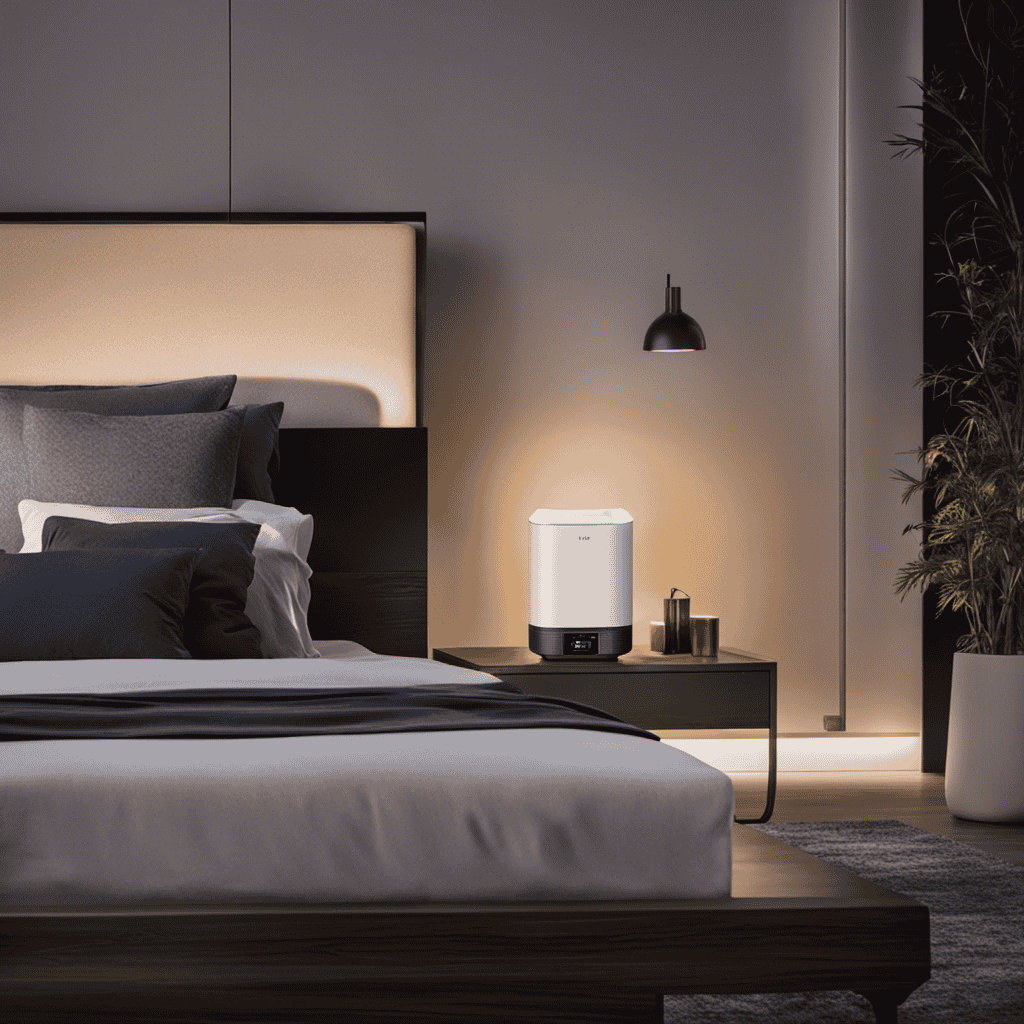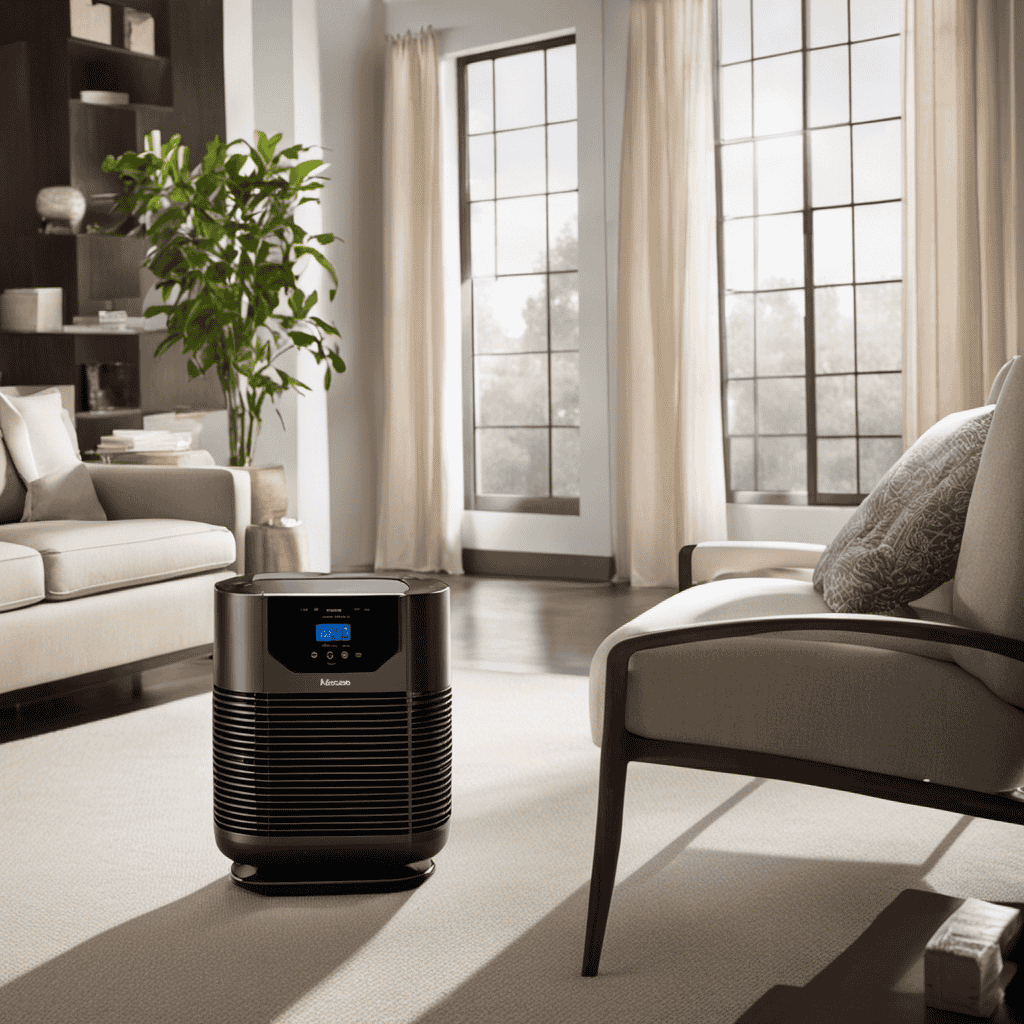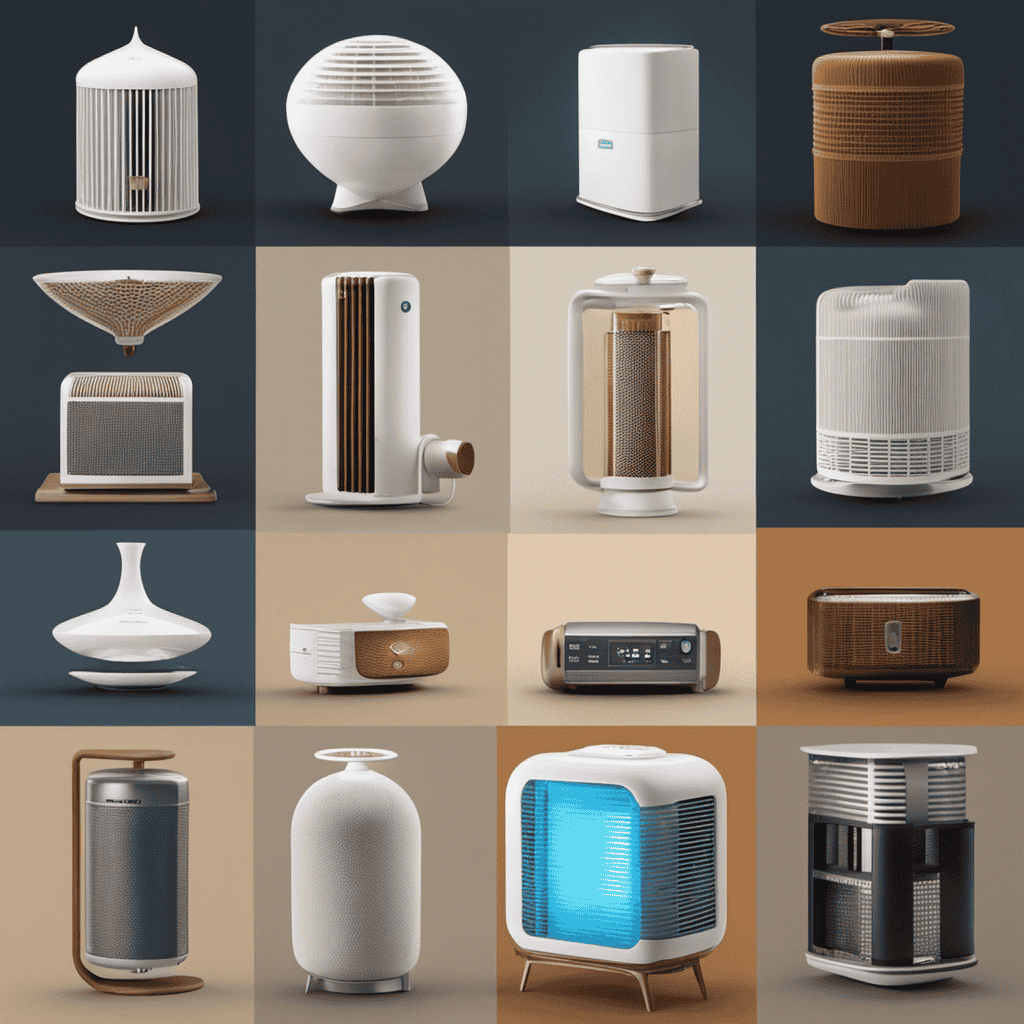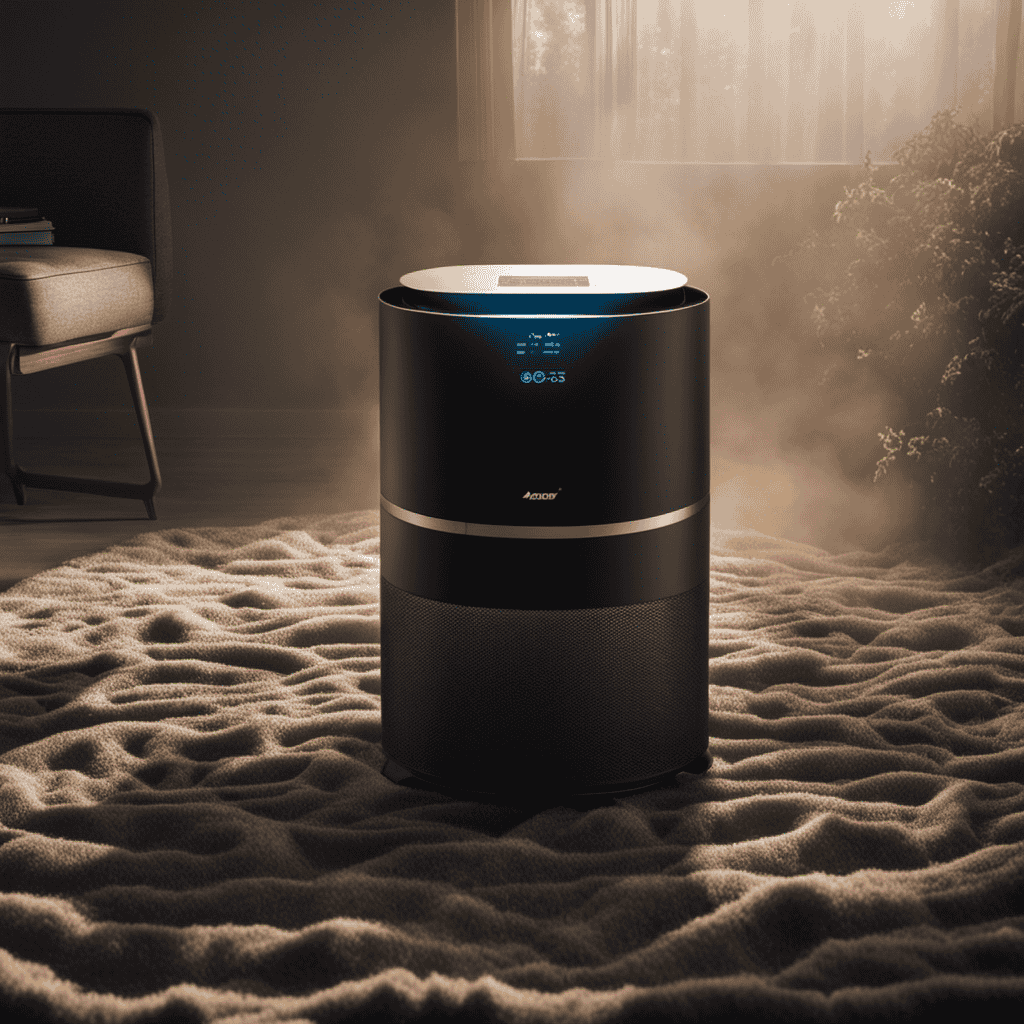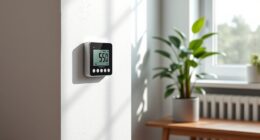You might be wondering – how is it possible that an air and odor purifier could actually cause an asthma attack? Believe it or not, it happens more often than you might imagine.
As someone who has dealt with asthma firsthand, I understand the importance of identifying and avoiding triggers.
In this article, we will explore the role of chemicals in triggering asthma attacks, how odors can aggravate symptoms, and the potential allergens in air purifiers that can worsen asthma.
Stay tuned for expert tips on choosing an asthma-friendly air purifier and minimizing triggers while using one.
Key Takeaways
- Chemicals, such as volatile organic compounds (VOCs) and airborne irritants, can trigger inflammation and bronchial constriction.
- Certain smells, particularly strong or chemical odors, can act as triggers for asthma attacks.
- Air purifiers filter and purify the air, reducing the concentration of allergens and irritants.
- Using air purifiers can lead to a significant decrease in asthma symptoms.
The Role of Chemicals in Triggering Asthma Attacks
Chemicals can play a significant role in triggering asthma attacks. The role of irritants in respiratory sensitization cannot be overlooked.
Certain chemicals, such as volatile organic compounds (VOCs) and airborne irritants, have the potential to trigger inflammation and bronchial constriction in individuals with asthma. VOCs, commonly found in cleaning products, paints, and air fresheners, can be particularly problematic. These chemicals can irritate the airways and cause an allergic response, leading to an asthma attack.
Additionally, airborne irritants like dust mites, pet dander, and pollen can also trigger respiratory sensitization and exacerbate asthma symptoms.
It is important for individuals with asthma to be aware of their surroundings and take necessary precautions to minimize exposure to these chemicals and irritants.
How Odors Can Aggravate Asthma Symptoms
When you have asthma, certain smells can make your symptoms worse. This is because asthma triggers, such as air pollutants, can irritate the airways and cause inflammation.
Odors, particularly strong or chemical smells, can act as potent triggers for asthma attacks. These odors can come from a variety of sources, including cleaning products, perfumes, paints, and certain foods. The chemicals present in these odors can irritate the sensitive airways of individuals with asthma, leading to symptoms such as wheezing, coughing, shortness of breath, and chest tightness.
It is important for individuals with asthma to be aware of their triggers and take steps to avoid them. This may include using fragrance-free and hypoallergenic products, keeping windows open for ventilation, and using air purifiers to remove air pollutants and odors from the indoor environment.
Understanding the Impact of Air Purifiers on Asthma
To better understand how air purifiers can help with your asthma symptoms, it’s important to consider their impact on the overall air quality in your home.
Air pollution is a major trigger for asthma symptoms, as it contains allergens, irritants, and pollutants that can worsen respiratory conditions. These harmful particles can come from various sources such as smoke, dust, pet dander, and pollen.
Air purifiers are designed to filter and purify the air, trapping and removing these pollutants from your indoor environment. By doing so, they reduce the concentration of allergens and irritants in the air, which can greatly benefit individuals with asthma.
Studies have shown that using air purifiers can lead to a significant decrease in asthma symptoms, including reduced coughing, wheezing, and shortness of breath. Additionally, air purifiers can create a healthier and cleaner living space by removing odors and improving overall air quality, providing a safer environment for asthma sufferers.
Potential Allergens in Air Purifiers That Can Worsen Asthma
Air purifiers, specifically those with HEPA filters, can effectively capture and remove potential allergens that may exacerbate asthma symptoms. These potential contaminants, such as dust mites, pet dander, pollen, and mold spores, are common respiratory irritants that can trigger asthma attacks. Understanding the presence of these allergens in air purifiers is crucial for individuals with asthma, as it allows them to make informed choices when selecting a purifier for their homes or workplaces.
To provide a comprehensive understanding, let’s explore the potential allergens commonly found in air purifiers:
| Allergen | Description |
|---|---|
| Dust Mites | Tiny insects that thrive in warm and humid environments, commonly found in bedding |
| Pet Dander | Microscopic flakes of skin shed by pets, a common allergen for individuals with asthma |
| Pollen | Fine powder released by plants, a major trigger for seasonal allergies |
| Mold Spores | Tiny reproductive units of molds, commonly found in damp areas and can cause allergies |
Factors to Consider When Choosing an Asthma-Friendly Air Purifier
Take into account the noise level and energy efficiency of the air purifier when choosing one that’s suitable for your asthma needs.
It’s important to consider the asthma-friendly features and filter effectiveness of the purifier to ensure it effectively removes allergens and irritants from the air.
Look for purifiers that have a high-efficiency particulate air (HEPA) filter as they’re known to be highly effective at capturing airborne particles, including allergens such as dust mites, pollen, and pet dander.
Additionally, consider air purifiers that have activated carbon filters to help remove odors and chemicals from the air. These filters can help eliminate potential triggers for asthma symptoms.
By carefully selecting an air purifier that meets your specific asthma needs, you can create a cleaner and healthier indoor environment.
Now, let’s explore some tips for minimizing asthma triggers while using an odor and air purifier.
Tips for Minimizing Asthma Triggers While Using an Odor and Air Purifier
When it comes to managing asthma triggers, choosing the right air purifier is crucial.
In this discussion, I will delve into the key points of selecting asthma-friendly purifiers, ensuring proper maintenance, and effective cleaning techniques.
Choosing Asthma-Friendly Purifiers
To select an asthma-friendly purifier, you’ll want to consider the specific features that can help alleviate your symptoms.
When it comes to filters, opt for purifiers that have asthma-friendly filters. These filters are designed to capture and remove common allergens and irritants that can trigger asthma attacks.
One of the most important types of filters for asthma sufferers is the HEPA filter. HEPA filters are highly efficient at trapping tiny particles, such as dust mites, pet dander, pollen, and mold spores, which are known to exacerbate asthma symptoms.
Additionally, look for purifiers with activated carbon filters, as they can help remove odors and volatile organic compounds (VOCs) from the air.
Proper Maintenance and Cleaning
Regularly cleaning and maintaining your asthma-friendly purifier is essential for optimal performance and to ensure it continues to effectively alleviate your symptoms. Proper maintenance can help prevent the accumulation of allergens and pollutants, which can trigger asthma attacks. Here are some maintenance tips and cleaning techniques to keep your purifier in top shape.
First, make sure to check and replace the filters regularly. Filters are responsible for trapping and removing harmful particles from the air. Over time, they can become clogged and lose their effectiveness. Follow the manufacturer’s instructions on when and how to replace the filters.
Additionally, clean the exterior of the purifier regularly to remove dust and dirt. Use a soft cloth or brush to gently wipe away any buildup. Avoid using harsh chemicals or abrasive materials that could damage the purifier.
Lastly, consider scheduling professional maintenance and servicing. This can help identify any potential issues and ensure your purifier is operating at its best.
Frequently Asked Questions
What Are the Common Types of Chemicals Found in Air Purifiers That Can Trigger Asthma Attacks?
As an expert in asthma triggers, I can tell you that common types of chemicals found in air purifiers that can trigger asthma attacks include volatile organic compounds (VOCs) and fragrances.
Can Air Purifiers Actually Worsen Asthma Symptoms Instead of Alleviating Them?
Using an air purifier can have potential side effects for asthma management. It’s important to consider indoor air quality and the effectiveness of purifiers. They may worsen symptoms instead of alleviating them.
Are There Any Specific Odors That Are Known to Aggravate Asthma Symptoms?
Common asthma triggers include strong odors, such as perfume or cleaning chemicals. These odors can irritate the airways and potentially trigger an asthma attack. Preventing asthma attacks involves avoiding these triggers and using proper air purifiers.
How Do Air Purifiers Remove Potential Allergens From the Air?
Air purifiers remove potential allergens by using filters to trap particles like pet dander and pollen. These filters can capture even tiny particles, improving air quality. However, certain odors emitted by air purifiers can trigger asthma attacks in some individuals.
Are There Any Specific Features or Technologies in Air Purifiers That Make Them More Asthma-Friendly?
As an expert in air purifiers, I can confidently say that there are specific features and technologies that make them more asthma-friendly. These include HEPA filters, activated carbon filters, and adjustable fan speeds.
Conclusion
In conclusion, it’s essential to understand the potential risks and benefits of using an odor and air purifier for individuals with asthma.
While air purifiers can help remove pollutants and allergens from the air, they may also release chemicals or particles that can trigger asthma symptoms.
One interesting statistic to consider is that a study found that 56% of asthmatic participants experienced worsening symptoms when using an air purifier that emitted ozone.
Therefore, it’s crucial to choose an asthma-friendly air purifier and take necessary precautions to minimize asthma triggers while using it.

